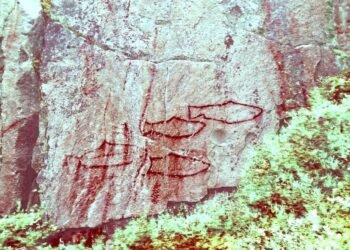In a field in southern Norway, a farmer and his son stumbled upon a rare Viking artifact while clearing stones for planting.
Øyvind Tveitane Lovra and his son Haakon were preparing their family farm in Suldal when Lovra picked up what he thought was a piece of metal trash. Upon closer inspection, he realized he was holding a rare Viking sword. Lovra immediately reported his discovery to the authorities.
The Archaeological Museum at the University of Stavanger and the Rogaland County Municipality confirmed the significance of the find. The sword, believed to date between 900 and 1050, is about 15 inches long—roughly half of its original length. Despite its age, the weapon is remarkably well-preserved, thanks to being buried in dense clay, which protected it from the elements.
Photographs of the sword reveal a rusty blade with a distinctive T-shaped handle and a blunt, rectangular end.

Through X-ray analysis, archaeologists uncovered an inscription on the blade. The inscription features a cross pattern and possibly letters, leading experts to speculate that the sword could be a VLFBERHT sword, a high-quality weapon produced in the Frankish Empire (modern-day Germany) during the Viking Age and early Middle Ages.
VLFBERHT swords are renowned for their superior craftsmanship and high carbon content, making them stronger than typical swords of the era. Only about 170 such swords with inscriptions have been discovered across Europe, with around 45 found in Norway. This particular find is the first of its kind reported in Rogaland.

Archaeologist Lars Søgaard Sørensen, who has 25 years of experience, and his colleague Kim Thunheim, who has been an archaeologist for 15 years, were among the first to examine the sword. Sørensen described the sword as a significant status symbol during the Viking Age. “The sword was the greatest status symbol in the Viking Age, and it was a privilege to be allowed to carry one. It is not often that we, as archaeologists, get to experience something like this,” Sørensen stated.
Lovra, who is also a chief engineer on the ferry MF Hydra and a local politician for the Centre Party, said: “I quickly realized that this wasn’t an everyday find. For me, it was a given that I should turn it in. It’s about our history, and it’s nice to learn about what has been here before.”
The find has also garnered attention from conservators and museum professionals. Hege Hollund, a conservator at the Archaeological Museum in Stavanger, noted the sword’s exceptional state of preservation despite Rogaland’s typically poor conditions for preserving such artifacts.
“This is a bit overwhelming and a fun day at work. There has been a concentration of sensations in recent years, including the gold find last year and the reliquary in the Cathedral recently,” Hollund remarked.
Professor Sigmund Oehrl of the University of Stavanger said: “When we first saw the sword, we were happy because it’s not often we get Viking Age swords. When we saw the X-ray image, we were really excited. We didn’t expect there to be an inscription on the blade.” He added that the inscription indicates the sword might be more special than initially thought.
The next steps for the archaeologists involve cleaning and conserving the sword to determine its precise age and better understand the meaning of its inscriptions.
Source: The Archaeological Museum at the University of Stavanger and the Rogaland County Municipality.























